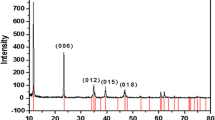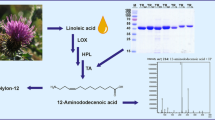Abstract
A new two-step chemo-enzymatic approach for highly efficient synthesis of all-trans-retinyl palmitate is constructed in this study. In the first step, retinyl acetate as starting material was fully hydrolyzed to retinol by potassium hydroxide. In the hydrolysis system, anhydrous ethanol was the best co-solvent to increase the solubility of retinyl acetate. The addition amounts of 5 M potassium hydroxide and anhydrous ethanol were 8 and 10 mL against 10 g retinyl acetate, respectively, and 100 % hydrolysis rate was obtained. In the second step, esterification was catalyzed by immobilized lipase on macroporous acrylic resin AB-8 using the extracted retinol and palmitic acid as substrates in non-aqueous system. After optimization, the parameters of esterification reaction were confirmed as follows: non-aqueous solvent was selected as n-hexane, washing times of extraction solution was four times, retinol concentration was 300 g/L, substrate molar ratio of retinol to palmitic acid was 1:1.1, the amount of immobilized enzyme was 10 g/L, and the esterification temperature was 30 °C. Under the optimal conditions, this protocol resulted in a 97.5 % yield of all-trans-retinyl palmitate in 700-L reactor. After purification, all-trans-retinyl palmitate was obtained with above 99 % of purity and 88 % of total recovery rate. This methodology provides a promising strategy for the large-scale production of all-trans-retinyl palmitate.






Similar content being viewed by others
References
Adlercreutz P (2013) Immobilisation and application of lipases in organic media. Chem Soc Rev 42(15):6406–6436
Ajima A, Takahashi K, Matsushima A, Saito Y, Inada Y (1986) Retinyl esters synthesis by polyethylene glycol-modified lipase in benzene. Biotechnol Lett 8(8):547–552
Blondel JCRG, Fouche JCL (1970) Phenthiazine derivatives. US Patent 3 627 759
Chen HC (2011) Optimization of ultrasound-accelerated synthesis of enzymatic caffeic acid phenethyl ester by response surface methodology. Ultrason Sonochem 18(1):455–459
Corey J, Dorogi PL, Meyers AJ, V. A (1999) Cosmetic composition with a retinol fatty acid ester. US Patent 5 885 595
Courraud J, Berger J, Cristol JP, Avallone S (2013) Stability and bioaccessibility of different forms of carotenoids and vitamin A during in vitro digestion. Food Chem 136(2):871–877
Dong H, Li Y, Sheng G, Hu L (2013) The study on effective immobilization of lipase on functionalized bentonites and their properties. J Mol Catal B Enzym 95(11):9–15
Duell EA, Kang S, Voorhess JJ (1997) Unoccluded retinol penetrates human skin in vivo more effectively than unoccluded retinyl palmitate or retinoic acid. J Invest Dermatol 109(3):301–305
Freitas L, Bueno T, Perez VH, Santos JC, Castro HFD (2007) Enzymatic hydrolysis of soybean oil using lipase from different sources to yield concentrated of polyunsaturated fatty acids. World J Microb Biotechnol 23(12):1725–1731
Gaspar LR, Campos PM (2007) Photostability and efficacy studies of topical formulations containing UV-filters combination and vitamins A, C and E. Int J Pharm 343(1):181–189
Gerster H (1997) Vitamin A—functions, dietary requirements and safety in humans. Int J Vitam Nutr Res 67(2):71–90
Gustafsson H (2013) Enzyme immobilization in mesoporous silica. Dissertation, Chalmers University of Technology
Ha SH, Anh TV, Lee SH, Koo YM (2012) Effect of ionic liquids on enzymatic synthesis of caffeic acid phenethyl ester. Bioprocess Biosyst Eng 35(1-2):235–240
Hanefeld U, Gardossi L, Magner E (2009) Understanding enzyme immobilisation. Chem Soc Rev 38(2):453–468
Janz GJ, Wait SC (1955) Space-time yield and reaction rate. J Chem Phys 23(8):1550–1551
Karmee SK (2009) Biocatalytic synthesis of ascorbyl esters and their biotechnological applications. Appl Microbiol Biotechnol 81(6):1013–1022
Liu ZQ, Zheng XB, Zhang SP, Zheng YG (2012) Cloning, expression and characterization of a lipase gene from the Candida antarctica ZJB09193 and its application in biosynthesis of vitamin A esters. Microbiol Res 167(8):452–460
Lousa D, Baptista AM, Soares CM (2013) A molecular perspective on nonaqueous biocatalysis: contributions from simulation studies. Phys Chem Chem Phys 15(33):13723–13736
Mateo C, Palomo JM, Fernandez LG, Guisan JM, Fernandez LR (2007) Improvement of enzyme activity, stability and selectivity via immobilization techniques. Enzyme Microb Technol 40(6):1451–1463
Mitsutaka T, Tadashi H, Kunio T (1994) Process for producing vitamin A derivatives. US Patent 5 424 478
Moreno PS, Filice M, Guisan JM (2013) Synthesis of ascorbyl oleate by transesterification of olive oil with ascorbic acid in polar organic media catalyzed by immobilized lipases. Chem Phys Lipids 174(3):48–54
Patrick A (2013) Immobilisation and application of lipases in organic media. Chem Soc Rev 42(15):6406–6436
Pommer H, Thieme P (1983) Industrial applications of the wittig reaction. Top Curr Chem 109(4):165–188
Poppe JK, Garcia GC, Matte CR, Fernandez LR, Rodrigues RC, Ayub MAZ (2013) Optimization of synthesis of fatty acid methyl esters catalyzed by lipase B from Candida antarctica immobilized on hydrophobic supports. J Mol Catal B Enzym 94(10):51–56
Prat D, Hayler J, Wells A (2014) A survey of solvent selection guides. Green Chem 16(10):4546–4551
Rejasse B, Maugard T, Legoy MD (2003) Enzymatic procedures for the synthesis of water-soluble retinol derivatives in organic media. Enzyme Microb Technol 32(2):312–320
Riaz MN, Asif M, Ali R (2009) Stability of vitamins during extrusion. Crit Rev Food Sci 49(4):361–368
Rodrigues RC, Ortiz C, Berenguer MA, Torres R, Fernández LR (2013) Modifying enzyme activity and selectivity by immobilization. Chem Soc Rev 42(15):6290–6307
Semba RD (1998) The role of vitamin A and related retinoids in immune function. Nutr Rev 56(1):S38–S48
Stergiou PY, Foukis A, Filippou M, Koukouritaki M, Parapouli M, Theodorou LG, Hatziloukas E, Afendra A, Pandey A, Papamichael EM (2013) Advances in lipase-catalyzed esterification reactions. Biotechnol Adv 31(8):1846–1859
Toshiya T, Shinzo S (2001) Dihalo-compound and process for producing vitamin A derivative. US Patent 6 388 124
Tung KH, Wilkens LR, Wu AH, McDuffie K, Hankin JH, Nomura AMY, Kolonel LN, Goodman MT (2005) Association of dietary vitamin A, carotenoids, and other antioxidants with the risk of ovarian cancer. Cancer Epidemiol Biomarkers Prev 14(3):669–676
Wang ZG, Wang JQ, Xu ZK (2006) Immobilization of lipase from Candida rugosa on electrospun polysulfone nanofibrous membranes by adsorption. J Mol Catal B Enzym 42(1):45–51
Wojtal KA, Wolfram L, Frey-Wagner I, Lang S, Scharl M, Vavricka SR, Rogler G (2013) The effects of vitamin A on cells of innate immunity in vitro. Toxicol in Vitro 27(5):1525–1532
Yadav GD, Devendran S (2012) Lipase catalyzed synthesis of cinnamyl acetate via transesterification in non-aqueous medium. Process Biochem 47(3):496–502
Yin CH, Liu T, Tan TW (2006) Synthesis of vitamin A esters by immobilized Candida sp. lipase in organic media. Chin J Chem Eng 14(1):81–86
Zhu K, Wang JQ, Wang YH, Liu H, Han PF, Wei P (2011) Synthesis of retinyl palmitate catalyzed by Candida sp.99-125 lipase immobilized on fiber-like SBA-15 mesoporous material. J Nanosci Nanotechnol 11(9):7593–7602
Zor T, Selinger Z (1996) Linearization of the Bradford protein assay increases its sensitivity: theoretical and experimental studies. Anal Biochem 236(2):302–308
Conflict of interest
The authors declare that they have no financial or non-financial conflict of interest in the publication of this manuscript.
Author information
Authors and Affiliations
Corresponding author
Electronic supplementary material
Below is the link to the electronic supplementary material.
ESM 1
(DOCX 1065 kb)
Rights and permissions
About this article
Cite this article
Liu, ZQ., Zhou, LM., Liu, P. et al. Efficient two-step chemo-enzymatic synthesis of all-trans-retinyl palmitate with high substrate concentration and product yield. Appl Microbiol Biotechnol 99, 8891–8902 (2015). https://doi.org/10.1007/s00253-015-6825-5
Received:
Revised:
Accepted:
Published:
Issue Date:
DOI: https://doi.org/10.1007/s00253-015-6825-5




